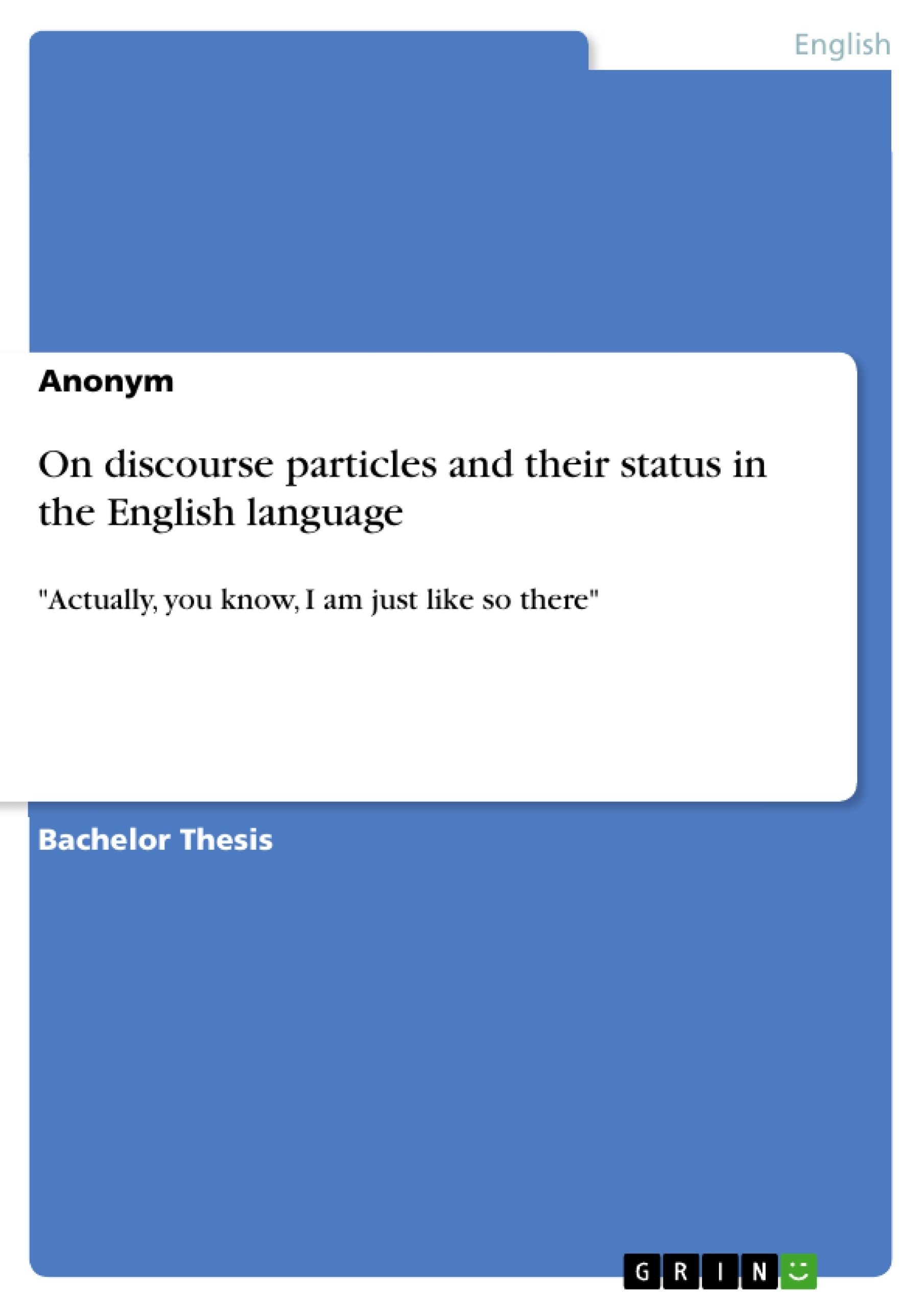The present paper compares the representations of “discourse particles” in the German and English language. In the first part of this study Zimmermann´s definition of the German “discourse particles” is outlined and complemented with results from studies by Thurmair (1989), Bublitz (1978), Waltereit (2001) and others that also worked on German discourse particles and put in contrast to concepts of words carrying discourse function in the English language. The study thereby focuses on the prototypical group of words that assume discourse function in the two languages, German modal particles and English discourse markers and illustrates its findings with two of their most prototypical representatives, German wohl and English actually. Both groups are compared in terminology, categorisation and in their morphological, semantic, pragmatic, and syntactic features.
Switching from synchronic to diachronic perspective, the study also traces their historical development and it is shown, how these functions developed. In course of this study, it is briefly referred to less prototypical ways of expressing discourse function and it is detected, that there are German particles, that seem to resemble English discourse markers and vice versa. Furthermore, it is touched upon the semantic‐pragmatic dispute on how to detect their meaning and it is referred to their role out of a sociolinguistic perspective.
Comparing the German and the English concept of “discourse particles”, the study is interested in prototypical behaviour and therefore chooses the most common approaches and terminology. Later on in the study, in chapter 2.3.3, it also takes into account less common uses.
Inhaltsverzeichnis (Table of Contents)
- Introduction
- How to call them and where to place them
- Terminology
- Terminology used for German words like wohl.
- Terminology used for English words like actually.
- Classification
- Classification of German modal particles.......
- Classification of English discourse markers.....
- Comparison
- How to identify them
- Morphologic characteristics
- Morphologic features of German modal particles.........
- Morphologic features of English discourse markers.
- Semantic-pragmatic characteristics.
- Semantic-pragmatic features of German modal particles.
- Semantic-pragmatic functions of German modal particles
- Semantic-pragmatic features of English discourse markers.
- Semantic-pragmatic functions of English discourse markers
- How to account for their multi-functionality..
- Syntactic characteristics.
- Syntactic features of German modal particles..
- Syntactic features of English discourse markers..
- How to understand them by tracing back their origins..
- Historical development of English discourse markers.
- Propositional function of actually.
- Textual function of actually..
- Interpersonal function of actually.
- Historical development of German modal particles.
- How can their difference be explained?
- Where are they heading to?
- Are there also English modal particles and German discourse markers?
- Conclusion
Zielsetzung und Themenschwerpunkte (Objectives and Key Themes)
This paper aims to explore and compare the representations of "discourse particles" in the German and English languages, particularly addressing the debate on whether Modern English lacks lexical equivalents of German modal particles. The study focuses on the prototypical examples of German "wohl" and English "actually" to illustrate the similarities and differences between the two language systems.
- Defining and classifying discourse particles in German and English
- Analyzing the morphological, semantic, pragmatic, and syntactic features of discourse particles
- Investigating the historical development of discourse particles in both languages
- Exploring the potential for cross-linguistic influence and the existence of German particles resembling English discourse markers and vice versa
- Addressing the debate on the semantic-pragmatic function and meaning of discourse particles
Zusammenfassung der Kapitel (Chapter Summaries)
- Introduction: The introduction presents the research question and the starting point of the study, which is the claim that English lacks discourse particles. It introduces the concepts of discourse markers and modal particles and provides a brief historical overview of the development of linguistic research on these items.
- How to call them and where to place them: This chapter deals with terminology and classification of discourse particles in both German and English. It compares the various terms used for these particles, discusses their different functions, and provides a framework for classifying them based on their linguistic features.
- How to identify them: This chapter focuses on the morphologic, semantic-pragmatic, and syntactic characteristics of discourse particles. It examines the grammatical features, meanings, and functions of these particles in both languages, highlighting their similarities and differences.
- How to understand them by tracing back their origins: This chapter investigates the historical development of discourse particles, tracing their origins and evolution over time. It explores how their functions have changed and adapted to different contexts and discusses the potential reasons for the observed differences between German and English.
- Are there also English modal particles and German discourse markers?: This chapter explores the possibility of cross-linguistic influence and the existence of German particles resembling English discourse markers and vice versa. It examines the semantic-pragmatic functions of these items and discusses the potential implications for understanding the role of discourse particles in language.
Schlüsselwörter (Keywords)
The key terms and concepts of this study include discourse particles, modal particles, discourse markers, English, German, "wohl", "actually", terminology, classification, morphology, semantics, pragmatics, syntax, historical development, cross-linguistic influence, and sociolinguistic perspective.
- Quote paper
- Anonym (Author), 2017, On discourse particles and their status in the English language, Munich, GRIN Verlag, https://www.grin.com/document/376362



